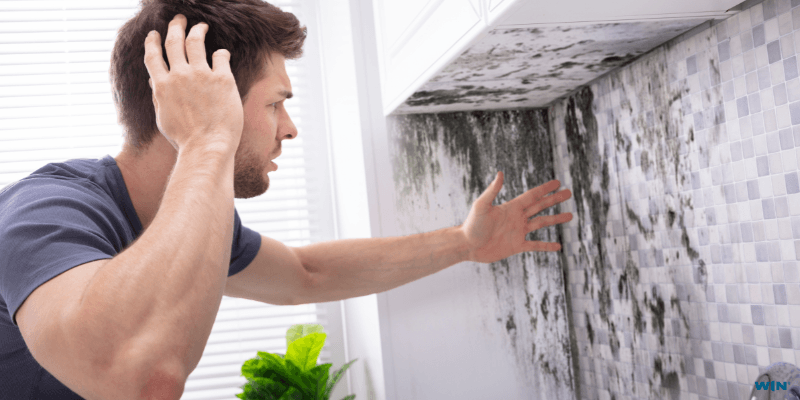There are certain things you don’t want to see in your home: rodents, damaged wiring, asbestos, leaks, and, of course, the dreaded black mold.
Alarmingly, up to 47% of homes are impacted by black mold each year. You could be breathing in thousands of mold spores without even knowing it.
Black mold isn’t just unsightly; it’s a health hazard linked to respiratory issues, allergies, and even skin problems. That’s why we’ve created this guide on how to remove black mold, exploring DIY methods and cutting-edge black mold treatments to help you safely eliminate mold and prevent its return.
Why Black Mold Is Harmful to Your Home and Health

Black mold can be one of several types of mold that stain walls dark green or black. One of the most well-known is Stachybotrys chartarum, a potentially toxic fungus that thrives in damp, humid environments. It’s often found in areas with water damage, such as near leaky roofs, flooded basements, or poorly ventilated bathrooms and attics.
Here are just a few ways black mold can affect your health and home.
Respiratory Issues
A healthy home should be mold-free. Mold in the home is connected to potentially dangerous respiratory conditions such as asthma. Medical experts believe that when your airways are exposed to mold spores, they produce more mucus and constrict in reaction. For asthma sufferers, this can bring on symptoms ranging from discomfort to restricted breathing.
Allergies are another serious concern, with symptoms including:
- Coughing
- Wheezing
- Runny nose
- Inflamed, watery eyes
- Nausea
- Fatigue
Children and seniors could be particularly susceptible to mold-related illness, as can those with compromised immune systems
Skin Problems
Skin irritation is another possible result of black mold infestation. If you normally have healthy skin but are suddenly experiencing dry, red, or flaky patches, you might want to test for mold. Of course, always consult your healthcare professional regarding any symptoms of illness.
Structural Damage
As well as potentially making you and your family ill, mold can eat away at your home. The fungus feeds on organic materials like wood and drywall, weakening the structure over time. Mold can also stain surfaces, leaving behind unsightly marks that are hard to remove.
Mold vs. Mildew: What’s the Difference?
According to the Environmental Protection Agency (EPA), both mold and mildew are terms for mold growth in a property. In most cases, mildew refers to early mold growth that appears as white or gray flat patches found in moist areas such as a bathroom or basement. Over time, mildew may darken and become similar to black mold.
If you notice pink or red mildew on your bathroom tiles or shower curtains, this is actually a type of yeast called Rhodotorula. Although usually harmless, it can cause illness in people with compromised immune systems. That’s why it’s so important to prevent or eliminate all types of fungal growth in your home.
Assess the Infestation Size: How To Spot Black Mold
Identifying black mold and understanding the severity of the infestation is crucial to preventing its spread and minimizing health risks while protecting your home. Here are just a few ways to check for mold in your home.
Visual Clues

A quick visual scan could uncover the following signs of black mold:
- Dark patches: Look for greenish-black or gray splotches on walls, ceilings, or floors.
- Water damage: Discoloration, bubbling paint, or warped surfaces could indicate mold growth underneath.
- Condensation: Mold loves moisture, so check areas with frequent condensation, like windowsills or pipes.
Non-Visual Clues
Mold isn’t always visible at first, so look out for these symptoms:
- Musty odor: A persistent earthy or damp smell is a telltale sign of mold, even if you can’t see it.
- Health symptoms: If you or your family experience unexplained allergies, respiratory issues, or headaches that improve when you leave the house, mold could be the culprit.
Common Problem Areas
If you want to make sure black mold isn’t an issue, check these areas.
- Bathrooms: Check behind toilets, under sinks, and around shower grout.
- Basements: Inspect corners, near sump pumps, and around windows.
- Kitchens: Look under the sink, around the dishwasher, and near the refrigerator.
- Attics: Examine roof leaks, insulation, and vents.
Homes with poor ventilation may have other areas that collect condensation, so check thoroughly around any areas you know struggle with excess moisture.
Black Mold Removal: Step-by-Step Guide

Removing black mold requires careful planning, the right tools, and a methodical approach. Whether you’re dealing with a small patch or a larger infestation, follow these steps to ensure safe and effective removal.
Before You Begin: Safety First
The first step is to gear up to ensure safety. Purchasing N95 masks or similar protects your lungs from inhaling mold spores. Rubber or nitrile gloves protect your skin from irritation. If you can get disposable coveralls, that will prevent spores from clinging to your clothes.
Before you start your black mold removal project, seal off the affected area with plastic sheeting and duct tape to prevent spores from spreading. Use a HEPA air purifier to filter airborne spores. Ventilation is also critical. Open windows and use fans to direct air outside, but avoid blowing air into other parts of the house.
Black Mold Treatment: Step One — Assessment
The first step is to assess the situation. Small Areas (<10 sq. ft) are typically safe for DIY removal. However, large infestations (>10 sq. ft) require a professional, especially if mold is in HVAC systems or hard-to-reach areas.
Step Two — The Right Gear
Now you need to gather your black mold treatment supplies, which should include the following:
Cleaning Solutions
- Vinegar: Non-toxic and effective on porous surfaces like wood and drywall
- Hydrogen peroxide: Great for non-porous surfaces like tiles and glass
- Baking soda: Mild abrasive for scrubbing
- Bleach: Only for non-porous surfaces (1:10 dilution with water, and never mix bleach with other cleaning chemicals)
Tools
- Stiff-bristled brush or sponge
- Spray bottle
- HEPA vacuum
- Bucket and cleaning cloths
If the mold infestation seems impossible to clear with tools like cloths and brushes, it’s time to call a professional.
Step Three — Loose Spore Removal
Use a HEPA vacuum to remove loose mold spores from surfaces. Empty the vacuum outside to prevent spores from re-entering your home.
Step Four — Black Mold Cleanup
Apply cleaning solutions to remove stains and kill the mold infestation. You’ll want to choose the right cleaner based on the surface type and severity of the mold.
For porous surfaces (drywall, wood, carpet), use the vinegar method:
- Fill a spray bottle with undiluted white vinegar
- Spray generously on the moldy area
- Let it sit for 1 hour to penetrate and kill the mold
- Scrub with a stiff brush, then wipe clean with a damp cloth
- Dry thoroughly with a fan or dehumidifier
Or baking soda paste:
- Mix 1 part baking soda with two parts water to form a paste
- Apply to the moldy area, scrub, and rinse with water For non-porous surfaces (tiles, glass, ceramics), use the hydrogen peroxide method:
- Use a 3% hydrogen peroxide solution
- Spray on the moldy area and let it sit for 10 minutes
- Scrub with a brush, then wipe clean
Or the bleach method:
- Mix 1 cup of bleach with 1 gallon of water
- Spray on the surface, let sit for 15 minutes, then scrub and rinse
- Caution: Bleach doesn’t kill mold roots on porous surfaces and can release harmful fumes
For fabrics and upholstery, use a vinegar and baking soda combo:
- Spray vinegar on the fabric, let sit for 1 hour, then scrub with a baking soda paste
- Rinse and dry completely in sunlight
Professional mold remediators often use fungicidal chemicals and treatments that kill black mold without causing damage to your home.
Step Five — Drying
Mold thrives in moisture, so drying is critical. Use fans, dehumidifiers, or open windows to speed up the process. You could also check for hidden moisture with a moisture meter.
Step Six — Disposal
Seal moldy materials, like destroyed carpet and drywall, in plastic bags before disposing of them. You’ll also want to thoroughly clean your tools with bleach or hydrogen peroxide to prevent cross-contamination.
Step Seven — Preventative Actions
Fix any source of moisture by repairing leaks, improving ventilation, or deploying a dehumidifier. You can also apply preventative treatments like mold-resistant paint and sealants. Clean areas weekly with vinegar or hydrogen peroxide to prevent mold growth from taking root.
Pro Tips for Specific Areas
Here are some additional tips when targeting areas highly prone to black mold.
Tips for how to kill black mold in basements:
- Scrub walls with vinegar or hydrogen peroxide
- Install a sump pump or dehumidifier to control moisture
- Seal cracks in walls or floors to prevent groundwater seepage
Removing and preventing black mold in showers:
- Spray hydrogen peroxide on grout and tiles, let sit for 10 minutes, then scrub
- Use a squeegee after every shower to keep surfaces dry
Black mold treatment for ceilings:
- Wear goggles to protect against falling spores
- Spray diluted vinegar, wait 1 hour, then gently wipe
- Fix roof leaks or improve attic ventilation to prevent recurrence
How to remove black mold in bathrooms:
- Use hydrogen peroxide or bleach on non-porous surfaces like tiles
- Install a humidity-sensing exhaust fan.
Black mold cleanup for dishwashers:
- Run a cycle with 1 cup of vinegar on the hottest setting
- Scrub the rubber seal with baking soda
- Leave the door open after each use to dry
Look Into Mold-Fighting Innovations
Consider these innovations to take your mold control initiatives to the next level.
- UV light HVAC systems: Neutralize spores circulating in your air ducts.
- Enzymatic cleaners: Eco-friendly sprays can break down mold at the molecular level
- Climate-controlled storage: If you're facing persistent mold problems, consider using self-storage units to protect your belongings. Many modern storage facilities offer climate-controlled storage environments that help prevent mold growth. These units often have monitored temperature and humidity levels, providing an extra layer of protection for your valuable items.
Professional home inspectors and mold mitigation specialists also utilize highly advanced mold tests and use equipment like infrared scanners to uncover hidden issues in your home. Talk to an expert to find out how their techniques help protect your home from mold.
Prevention Tips
One of the most important steps in black mold mitigation is prevention. Mold thrives in moist environments, so one of the simplest ways you can prevent growth is by removing sources of moisture.
Dry all surfaces after you clean them, particularly walls and other porous areas. If you have condensation, consider utilizing a dehumidifier to reduce this. You can also improve the ventilation in your home, as good airflow can prevent the buildup of moisture and reduce the likelihood of mold growth.
If you have a leaky pipe or other plumbing issue, or water gets into your house due to a storm, you must get the area dried out thoroughly. Lingering moisture is one of the major causes of mold.
When to Call a Pro for Mold Treatment
Sometimes, DIY mold remediation techniques aren’t sufficient. Here are situations that require a professional:
- Large infestations: Where mold covers more than 10 sq. ft
- Hidden mold: If you suspect mold behind walls or in HVAC systems
- Health concerns: If you or your family experience severe symptoms
Professionals use advanced tools, such as HEPA vacuums and antimicrobial sprays, to detect and remove mold safely.
DIY Mold Testing
You can source DIY mold test kits, which are affordable and easy to use. These kits let you collect samples and send them to a lab for analysis.
However, sometimes, professional inspections are necessary. Black mold issues often go unnoticed for years. Experts use thermal imaging cameras and moisture meters to detect hidden mold behind walls or under floors.
Professional mold removal typically ranges from $500 to $6,000, while DIY cleanup supplies cost around $50 to $150.
Final Takeaway
Now you understand how to kill black mold yourself and when to call a professional. By pairing proactive moisture control with smart cleaning habits and cutting-edge tools, you’ll protect your home’s value and your family’s well-being.
Stay dry, stay clean, and breathe easy. And, when you’re not sure if black mold is the problem, trust the experts at WIN Home Inspection to give you the right answers. It’s easy to book a thorough, professional mold inspection with WIN today. Call us at (800) 309-6753 or email info@wini.com, and one of our specialists will gladly assist you.
FAQ
Can I remove black mold myself?
Yes—if the area is small and you can source the right cleaning solutions and tools. Always wear protective gear and ventilate the space well.
What kills black mold instantly?
Hydrogen peroxide or undiluted vinegar can work for small areas. Professionals use stronger treatments for larger infestations.
Is black mold always toxic?
Black mold isn’t toxic to everyone, because immune systems can react differently to pathogens. However, black mold mitigation is critical to protect your family’s health and prevent damage to your home.
Get the Latest Insights!
Sign up to stay up to date with latest tips, trends and updates from WIN.











